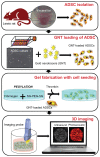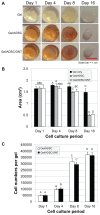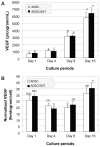Evaluation of gold nanotracers to track adipose-derived stem cells in a PEGylated fibrin gel for dermal tissue engineering applications
- PMID: 23345978
- PMCID: PMC3551459
- DOI: 10.2147/IJN.S36711
Evaluation of gold nanotracers to track adipose-derived stem cells in a PEGylated fibrin gel for dermal tissue engineering applications
Abstract
Evaluating the regenerative capacity of a tissue-engineered device in a noninvasive and synchronous manner is critical to determining the mechanisms for success in clinical applications. In particular, directly tracking implanted cells in a three-dimensional (3D) scaffold is desirable in that it enables the monitoring of cellular activity in a specific and localized manner. The authors' group has previously demonstrated that the PEGylation of fibrin results in a 3D scaffold that supports morphologic and phenotypic changes in mesenchymal stem cells that may be advantageous in wound healing applications. Recently, the authors have evaluated adipose-derived stem cells (ASCs) as a mesenchymal cell source to regenerate skin and blood vessels due to their potential for proliferation, differentiation, and production of growth factors. However, tracking and monitoring ASCs in a 3D scaffold, such as a PEGylated fibrin gel, have not yet been fully investigated. In the current paper, nanoscale gold spheres (20 nm) as cell tracers for ASCs cultured in a PEGylated fibrin gel were evaluated. An advanced dual-imaging modality combining ultrasound and photoacoustic imaging was utilized to monitor rat ASCs over time. The ASCs took up gold nanotracers and could be detected up to day 16 with high sensitivity using photoacoustic imaging. There were no detrimental effects on ASC morphology, network formation, proliferation, and protein expression/secretion (ie, smooth muscle α-actin, vascular endothelial growth factor, matrix metalloproteinase-2, and matrix metalloproteinase-9) associated with gold nanotracers. Therefore, utilization of gold nanotracers can be an effective strategy to monitor the regenerative process of a stem cell source in a 3D gel for vascular and dermal tissue engineering applications.
Keywords: adipose-derived stem cells; angiogenesis; fibrin; gold nanoparticles; tissue engineering; ultrasound and photoacoustic imaging.
Figures









Similar articles
-
Combined ultrasound and photoacoustic imaging to noninvasively assess burn injury and selectively monitor a regenerative tissue-engineered construct.Tissue Eng Part C Methods. 2015 Jun;21(6):557-66. doi: 10.1089/ten.TEC.2014.0306. Epub 2015 Jan 19. Tissue Eng Part C Methods. 2015. PMID: 25384558 Free PMC article.
-
Fibrin-based 3D matrices induce angiogenic behavior of adipose-derived stem cells.Acta Biomater. 2015 Apr;17:78-88. doi: 10.1016/j.actbio.2015.01.012. Epub 2015 Jan 16. Acta Biomater. 2015. PMID: 25600400 Free PMC article.
-
A bilayer construct controls adipose-derived stem cell differentiation into endothelial cells and pericytes without growth factor stimulation.Tissue Eng Part A. 2011 Apr;17(7-8):941-53. doi: 10.1089/ten.TEA.2010.0294. Epub 2011 Jan 4. Tissue Eng Part A. 2011. PMID: 21083419 Free PMC article.
-
Impact of Age on Human Adipose Stem Cells for Bone Tissue Engineering.Cell Transplant. 2017 Sep;26(9):1496-1504. doi: 10.1177/0963689717721203. Cell Transplant. 2017. PMID: 29113460 Free PMC article. Review.
-
Adipose stem cells: biology, safety, regulation, and regenerative potential.Clin Plast Surg. 2015 Apr;42(2):169-79. doi: 10.1016/j.cps.2014.12.007. Clin Plast Surg. 2015. PMID: 25827561 Review.
Cited by
-
Photoacoustic imaging of cells in a three-dimensional microenvironment.J Biomed Sci. 2020 Jan 17;27(1):3. doi: 10.1186/s12929-019-0594-x. J Biomed Sci. 2020. PMID: 31948442 Free PMC article. Review.
-
Iron administration before stem cell harvest enables MR imaging tracking after transplantation.Radiology. 2013 Oct;269(1):186-97. doi: 10.1148/radiol.13130858. Epub 2013 Jul 12. Radiology. 2013. PMID: 23850832 Free PMC article.
-
Photoacoustic Imaging in Tissue Engineering and Regenerative Medicine.Tissue Eng Part B Rev. 2020 Feb;26(1):79-102. doi: 10.1089/ten.TEB.2019.0296. Epub 2020 Jan 14. Tissue Eng Part B Rev. 2020. PMID: 31854242 Free PMC article. Review.
-
Non-invasive and Non-destructive Characterization of Tissue Engineered Constructs Using Ultrasound Imaging Technologies: A Review.Ann Biomed Eng. 2016 Mar;44(3):621-35. doi: 10.1007/s10439-015-1495-0. Epub 2015 Oct 30. Ann Biomed Eng. 2016. PMID: 26518412 Free PMC article. Review.
-
Ultrasound-guided photoacoustic imaging-directed re-endothelialization of acellular vasculature leads to improved vascular performance.Acta Biomater. 2016 Mar 1;32:35-45. doi: 10.1016/j.actbio.2015.12.029. Epub 2015 Dec 18. Acta Biomater. 2016. PMID: 26708553 Free PMC article.
References
-
- Espandar L, Bunnell B, Wang GY, Gregory P, McBride C, Moshirfar M. Adipose-derived stem cells on hyaluronic acid-derived scaffold: a new horizon in bioengineered cornea. Arch Ophthalmol. 2012;130(2):202–208. - PubMed
-
- Lalande C, Miraux S, Derkaoui SM, et al. Magnetic resonance imaging tracking of human adipose derived stromal cells within three-dimensional scaffolds for bone tissue engineering. Eur Cell Mater. 2011;21:341–354. - PubMed
-
- Kreitz S, Dohmen G, Hasken S, Schmitz-Rode T, Mela P, Jockenhoevel S. Nondestructive method to evaluate the collagen content of fibrin-based tissue engineered structures via ultrasound. Tissue Eng Part C Methods. 2011;17(10):1021–1026. - PubMed
Publication types
MeSH terms
Substances
Grants and funding
LinkOut - more resources
Full Text Sources
Other Literature Sources
Medical
Miscellaneous

